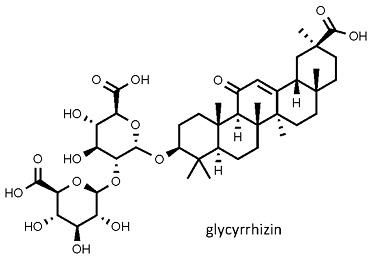 Glycyrrhiza glabra
Glycyrrhiza glabra
liquorice • licorice
Back to “Spices: licorice (Glycyrrhiza glabra)rh; liquorice (Glycyrrhiza glabra)rh”
Glycyrrhiza glabra L. (Fabaceae); soethout (Afrikaans); yang gan cao (Chinese); zoethout (Dutch); réglisse (French); Echtes Süßholz, Lakritze (German); glykoriza (Greek); liquirizia (Italian); you kanzou (Japanese); alcaçuz (Portuguese); orozuz, regaliz (Spanish); lakrits (Swedish); meyan kökü (Turkish)
DESCRIPTION Dried rhizomes (“liquorice root”) are woody pieces of underground stem, bright yellow inside and covered with fissured brown bark. “Licorice” is the spelling used in the United States and Canada. Chinese liquorice or gan cao (“sweet herb”, G. uralensis) is a close relative used in the same way.1
THE PLANT A suffrutex (up to 1 m or ca. 3 ft) with branched and spreading rhizomes and erect above-ground stems bearing pale purple flowers and small, few-seeded pods.
ORIGIN Mediterranean region to central Asia.1 Uses date back to the time of the ancient Assyrians and Romans.1,2 Spanish monks at Pontefract in Yorkshire maintained a monopoly during the 16th century1,2 and the town became the centre of the liquorice industry. The famous coin-shaped sweets known as Pontefract cakes (also Pomfret or Pomfrey cakes) were manufactured here during ca. 1660 to 1960.1 Today, liquorice is grown commercially in many countries, including the Mediterranean region (North Africa, France, Italy, Spain), Russia, Turkey, India and China.1,3
CULTIVATION Liquorice can be propagated from seeds but plants are more often grown from pieces of rhizome. Plants grow best in warm, temperate regions and require full sun and deep soil.
HARVESTING Rhizomes are harvested in the autumn, three to five years after planting. The whole plant is dug up and the rhizomes cleaned and trimmed. They may also be boiled in water to create black liquorice syrup that is concentrated and dried by boiling and/or spray-drying.
CULINARY USES Liquorice juice is mostly used as a flavourant in confectionery (e.g. gingerbread), sweets, candies, desserts, stewed fruit and drinks such as liquorice water, mulled wine, root beer, dark beer (stout) and liqueurs.2,3 Liquorice not only reduces the bitter taste of beer and ale but also increases the foaming. Liquorice water is a refreshing cold drink resembling coconut milk that is made by infusing sliced rhizomes in water and adding lemon juice or orange peel for extra flavour.3 Liquorice is used to a limited extent as a culinary spice in China, adding flavour and a hint of sweetness to savoury foods, sauces and stews (especially pork). Liquorice is an ingredient of Chinese functional food mixtures known as bupins.4 Rhizome pieces may be chewed as a sweet snack. Various types of hard or pliable liquorice sweets are made by mixing the juice (concentrate) with gum arabic, starch or icing sugar and flavouring agents.2 Such sweet or salty black liquorice sweets (known as “drop”) are particularly popular in the Netherlands.
FLAVOUR COMPOUNDS Liquorice extracts contain 5–10% glycyrrhizin, a triterpenoid glycoside (saponin) that is 50 times sweeter than sucrose, with a strong aftertaste typical of liquorice.1,3

NOTES Liquorice is a useful sweetener for diabetics but repeated use of large amounts may be harmful. Large quantities are used in the pharmaceutical industry and as flavouring agent for tobacco.3
1. Mabberley, D.J. 2008. Mabberley’s plant-book (3rd ed.). Cambridge University Press, Cambridge.
2. Larousse. 1999. The concise Larousse gastronomique. Hamlyn, London.
3. Farrel, K.T. 1999. Spices, condiments and seasonings. Aspen Publishers, Gaithersburg, USA.
4. Hu, S.-Y. 2005. Food plants of China. The Chinese University Press, Hong Kong.